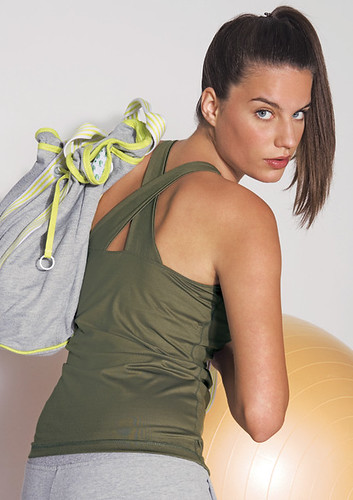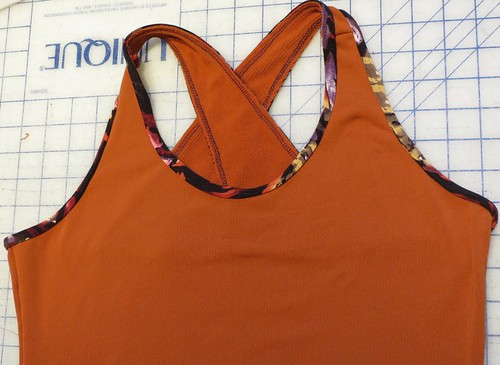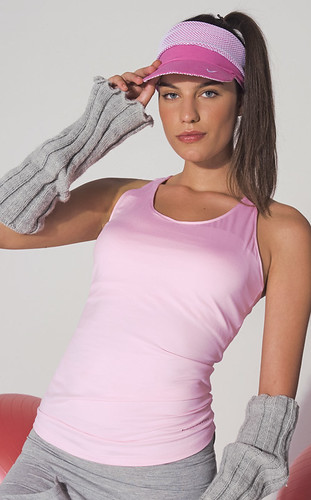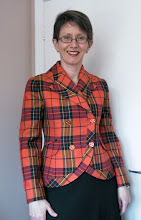Of course I had to try it out right away. Of course, I didn't pick an "easy" project. I made a fleece yoga top from the November, 2007 issue of Burda Magazine.
 It's simple enough to put together. Front, back and straps.
It's simple enough to put together. Front, back and straps. But the fun part was adding a jersey fabric binding at all edges. It's the technique I wrote about here.
I had to do quite a lot of practice strips to get the hang of coverstitching through 2 layers of fleece and 3 layers of jersey. The needles were not consistently picking up the lower looper thread. This is a problem because a coverstitch is an elaborate chain stitch, and any open loop means the whole shebang can pull out. Experimentation revealed that it is important to use heavier needles and pay attention to the tension settings for heavier fabric. Also, using woolly nylon thread in the lower looper produced more consistent results.
Anyway, this is my first effort. Don't look too close. I used scraps leftover from this top for the binding.
 |
| Experiment no. 1 |
Then I made another, using fleece scraps leftover from the jacket blogged here for the body, and jersey scraps leftover from the faux-wrap dress blogged here for the binding. It's very cozy. And I did a better job. But I'm not showing you the hem. It's not up to my usual standards.
 |
| Experiment no. 2 |
They'll be nice and cozy as an under-layer for curling and skiing ... that is, if we ever get any snow.




You do realise that the moment you say 'don't look too close', I immediately want to look really close! :)
ReplyDeleteSounds like once you get the hang of things, it will be a fabulous machine to have. Your second go around already looks heaps better!
I have been looking at this machine. Now I am tempted a little more.
ReplyDeleteTerry
I have the earlier, 1000cs and have had absolutely no trouble with it and I've had for quite a few years. Enjoy. One thing that seemed to be common with the machine, there's a huge thread on it over on PR is that it came in with the presser foot pressure very tight and the instructions for loosening it were backwards. ie right for loosening and left for tightening, and it's the reverse. This would definitely affect hems. I ended up loosening the pressure by quite a bit. I didn't have a coverstitch on my serger so buying a stand alone made sense, but also like you I really didn't want to have to change set up all the time. It's a machine that does one thing very well.
ReplyDeleteThanks for posting this top. I have this issue and totally forgot about this pattern when searching for a work-out tank pattern.
ReplyDeleteThey look great and I'm incredibly jealous of your coverstitch machine!
This is a really nice top and I love the way you used print fabric for the bindings. I've made a bunch of racerback tanks, but never any with X straps. I think I'll have to try this one.
ReplyDeleteKay, a cover machine is a wonderful thing. I use it to copy a binding technique that Arc'teryx uses with great success.
ReplyDeleteCut the binding four times the finished width. Apply the binding to the outside with right sides facing. Fold the binding to the inside but do not fold over the unfinished edge of the binding. Pin or baste in place. Basting is best - sorry. Now place under the cover hem presser foot so the right hand line of stitches is in the ditch. This is why basting works best. The left hand line of stitches will cover the edge of the binding inside. You end up with a nice flat binding that is very stretchy and a detail just along the edge of the garment fabric edge before the binding. Look at an Arc'teryx garment to see it as they use it on most of their stuff. Gets the bulk out.
I alos use the cover hem on shoulder seams of sports garments to reduce the bulk so my pack straps don't have to compress four layers of fabric. Just remove the seam allowance on the top seam, lap the seams and cove hem from the top or bottom if you want a stitch detail to show. Great for fleece.
What a nice little addition to your sewing room! And I'm waiting for the snow, too......
ReplyDelete